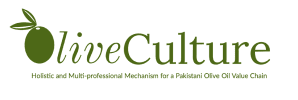It will not be an exaggeration if we say harvesting is one of the most important steps in the olive crop’s lifecycle; as it is crucial both for the fruit being harvested in the current season as well as the production the following year. The choice of time and modality for its execution strongly affect the quantity and quality of the oil, the production of the crop the following year and the economical convenience of its execution. In this blog we will talk about the ideal time and methods for olive harvesting and share the in-depth knowledge brought to the Pakistani olive industry by the Italian experts through the OliveCulture project. The project is dedicated to the growth of Pakistan’s budding olive industry, here we share some valuable cultural harvesting practices brought from years of experience by the Italian experts through OliveCulture.
OPTIMAL TIME FOR OLIVE PICKING:
The optimal period to perform the harvesting is to be determined by a number of factors. You have to ask yourself if you are harvesting for the purpose of oil production or for olive consumption as a fruit in pickles etc. It also depends on your cultivar, some are ideal for oil production while others are favored for their flavor profile. If your main purpose is oil production you will choose a time when you have the maximum quantity and quality of the oil. Olives are harvested in autumn and winter when the fruit becomes mature, the best time for harvesting of olives that are used for oil production is when the oil content is high; that will be when the pit-to-pulp ratio is small.
Olive maturity and cultivar are the main determinants of olive oil flavor and quality. On ripening color changes from yellowish green – reddish purple – finally black. In most cases, the best quality is obtained by harvesting the fruits when their pigmentation regards about 50% of the epicarp (surface pigmentation); indeed, with the starting of deep pigmentation (pulp pigmentation), usually, there is a decrease in the quality level of the extracted oil (i.e. reduction in volatile compounds, pigments, and polyphenols contents).
HARVESTING TECHNIQUES:
There are manual harvesting techniques where you obtain a better quality fruit but it comes with a high labor expense and is time consuming, on the other hand mechanical harvesting is a cheaper and more time efficient process that comes with the risk of damage to the fruit or crop if not carried out carefully.
MANUAL HARVESTING:
It is normally done by using nets under the trees, ladders, and manual combs in the case of cultivars for the production of oil. It is a system that allows obtaining high-quality oils, because, with this system, damages to the fruits during the harvesting operations are minimized. The productivity of workers is relatively low i.e 5- 10 kg/h. It is also dangerous to use ladders for fruit picking. That is why farmers who plan to perform manual harvesting must keep in mind that to improve the efficiency of manual harvesting it is important to limit the height development of the trees. The maximum quantity and quality of the oil do not always match; in this case, you have to choose what to privilege: quantity or quality. – The prolonged period of mature olive fruits on the tree reduces the oil quality level and increases the risk of diseases and pest attacks. Dropped olives must not be harvested, because the quality of the oil obtained from them is very low; however if olives are harvested from the ground, they have to be kept and processed separately.
AIDED (WITH HAND-HELD MACHINES) AND MECHANICAL (WITH TRUNK SHAKERS) HARVESTING :
If well performed and if olives are processed soon after harvesting, they do not have significant negative effects on olive oil quality and on tree integrity. With respect to manual harvesting, aided harvesting systems can have positive effects on olive oil quality since fruit picking is concentrated in the chosen period. In large farms with very productive olive trees, machines allow to reduce the need for manpower and reduce production costs.
An important practice to keep in mind while using aided or mechanical harvesting is the use of nets under the trees to avoid fruit contact with the ground. Ventilated plastic boxes must be used for transport and storage of olives. Separate the fruit from shoots and leaves.
Sticks should not be used to remove fruit from the trees as it will lead to:
– A decrease in production in the next season, because of damages caused to shoots
– A possible high incidence of some diseases. Fruit injuries and consequently a worsening of oil quality
It is also crucial to keep in mind never to use nylon bags for the transportation and storage of olives because they create conditions such as heating and fermentation that lead to the worsening of oil quality.
POST-HARVEST HANDLING OF OLIVES:
Post harvest handling is as important as the harvesting itself, if olives are stored for more than 48 hours it will lead to the reduction in the quality of olives and subsequently the oil produced from these olives. As storage for longer periods leads to fermentation which will strongly affect the flavor profile of the fruits and the quality of the oil produced from those olives.
It is strongly advised to make an appointment at the mill and send olives everyday according to the capacity of the mill, the ideal time between harvesting and milling is 24 hours to a maximum of 48 hours. Even during this time the olives must be kept in plastic boxes or spread in a 10 cm layer, in an area that is clean, dry, odorless, cool, well-ventilated as well as in shade with no direct sunlight.
